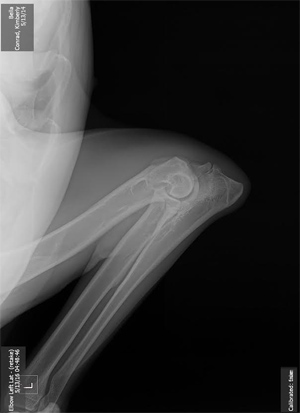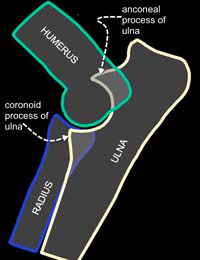 Canine Hip Dysplasia is a well-known condition resulting in abnormal growth of the hip joint leading to instability which causes degenerative joint disease (arthritis). The hip is a ball and socket joint wherein the ball should fit snugly into the socket. When it does not fit ideally, the ball rolls around loosely in the socket wearing away cartilage and eroding the edges of the socket, as well as stretching the joint’s soft tissue. These abnormal movements lead to the formation of scar tissue and bone spurs, and is quite painful.
Canine Hip Dysplasia is a well-known condition resulting in abnormal growth of the hip joint leading to instability which causes degenerative joint disease (arthritis). The hip is a ball and socket joint wherein the ball should fit snugly into the socket. When it does not fit ideally, the ball rolls around loosely in the socket wearing away cartilage and eroding the edges of the socket, as well as stretching the joint’s soft tissue. These abnormal movements lead to the formation of scar tissue and bone spurs, and is quite painful.
Risk factors include genetics, nutrition, and exercise, with genetics being the most influential of the three. Some young dogs with mild hip dysplasia will show no problems until middle age, especially if they are managed with proper weight, exercise, and perhaps nutritional supplements protective of cartilage and joint fluid. There are no hard studies to indicate the beneficial effects of supplements, but it is a logical option that might help, and certainly will do no harm. Medical treatments include oral and injectable agents to help control pain, inflammation, and supply molecular building blocks of normal joint (and joint fluid) materials.
 Medical management for all cases includes weight control (very important!), appropriate exercise (low impact activities such as walking and swimming), and avoidance of potentially harmful activities (jumping up onto furniture, jumping in the air for Frisbee, running on roads for miles), a good supportive bed, and non-slip walking surfaces. Canine rehabilitation/physical therapy can show the owner exercises to strengthen the supporting structures around the hips, and help the dog gain and maintain strength to decrease the speed of progression of the degenerative changes that will come.
Medical management for all cases includes weight control (very important!), appropriate exercise (low impact activities such as walking and swimming), and avoidance of potentially harmful activities (jumping up onto furniture, jumping in the air for Frisbee, running on roads for miles), a good supportive bed, and non-slip walking surfaces. Canine rehabilitation/physical therapy can show the owner exercises to strengthen the supporting structures around the hips, and help the dog gain and maintain strength to decrease the speed of progression of the degenerative changes that will come.
There are surgical options available depending on the age of the dog and the severity of the condition at diagnosis. Several surgical techniques involve cutting the pelvis and reattaching the pieces in such a way that changes the angle at which the socket of the hip covers the ball of the femur. The result is better coverage and a tighter, more normal fit of the joint pieces. These two techniques are juvenile pubic symphysiodesis (JPS) and double or triple (depending if two or three cuts are made in the pelvis) pelvic osteotomy. They are typically used in puppies less than ten months of age with no evidence of arthritis. Careful radiographic evaluation is needed to make the proper selection for these techniques.
Another surgical option is an FHO or femoral head ostectomy, this removed the femoral head (ball part of the joint), and thereby relieves the pain of the severely arthritic or loose joint. The muscles around the joint form a supportive “false joint”. This will not make the dog greatly more active and sound, but will relieve the discomfort. It is a good option for small and medium sized dogs. Dogs can also have a total hip replacement where both the ball and the socket portions of the joint are replaced, much like the same surgery in a person. This procedure not only relieves pain, but offers the mechanics of a normal joint allowing normal motion.
If your dog has been diagnoses with canine hip dysplasia, please seek out a rehabilitation practitioner to help you and your veterinarian manage the condition in the best possible way. Proper management and exercise can keep your dog going strong for several more years. The best way to decrease hip dysplasia in our canine population is to only purchase puppies from verified health tested parents, and never breed without evaluating the genetic predispositions of the individuals in question.
Schedule Your Pets, Initial Examination/Consultation
Canine Rehabilitation & Conditioning: (251) 945-7555

Recent Comments